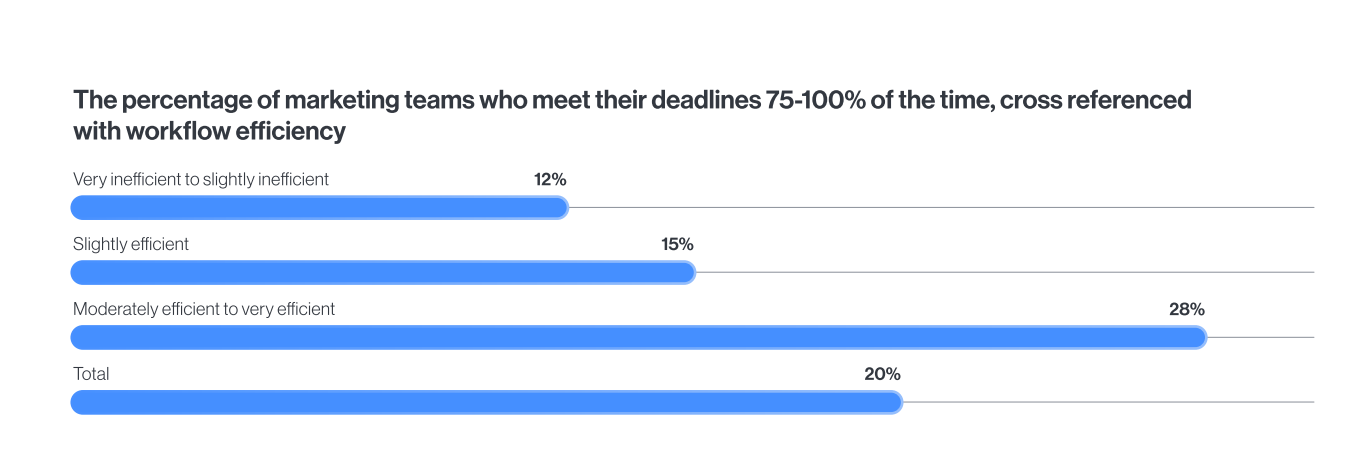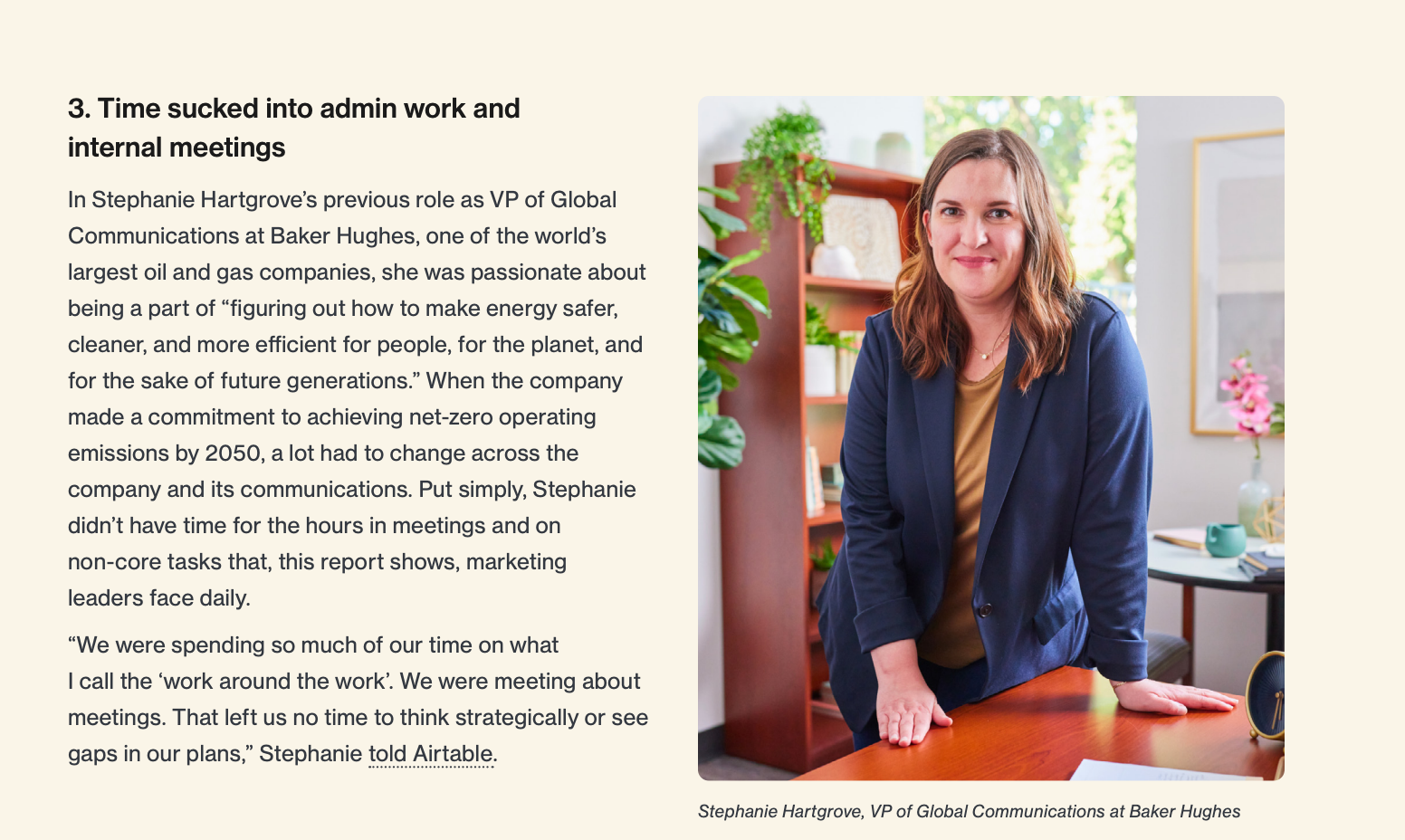Article's Content
If there’s one thing all marketers know, it’s this: our industry changes constantly.
Over the last decade, we’ve witnessed the emergence of countless marketing trends as the key to success — from strategic approaches to growth channels to niche fields.
Not to mention the fact that the martech industry has grown from 150 tools in 2011 to nearly 10,000 today!
If you’re a pro, you’ve internalized the fact that there will always be new marketing trends and industry developments to contend with.
That said, the past few years have taken the term “new reality” to another level.
A global pandemic, economic downturn, and shifting workforce priorities have drastically changed what marketers experience in their day-to-day, at a breakneck pace to boot. Unfortunately, these changes aren’t all for the better.
In 2022, we can expect:
- New content and campaign workloads that have increased over 50% since 2021
- A new economic downturn adding pressure on marketers to drive revenue and prop up stagnating growth
- A revolving door of new tools in the martech stack, with over 82% of marketers planning to change their arrangement in 2022
- New reliance on a remote-hybrid model that silos teams and makes collaboration more challenging
Worse still, these developments are exacerbating already pervasive issues negatively impacting the organizational talent pool — reduced engagement, increased burnout, and rapid employee turnover, to name a few.
To dig deeper into the numbers behind these high-level issues, Airtable interviewed 300 senior marketers, 70% of whom come from enterprise companies with 1,000 + employees. They also sat down with top marketers from companies like Equinox, Baker Hughes, Panavision, and West Elm to dive into the qualitative experience of navigating these changes.
Airtable’s Marketing Trends 2022 Report is a must-read for department heads in any industry that’s feeling extra pressure as we close out the year’s final quarter.
The Numbers Behind this Stressful New Reality
Airtable’s report provides over 50 distinct insights based on responses from hundreds of senior marketers. Diving into the data, Airtable identifies macro trends relevant to all marketing departments, regardless of the industry.
The 5 insights below are just a taste of the valuable intel revealed in this report. Take a look for yourself:
Only 20% of marketing teams report consistently meeting deadlines
Missing deadlines is an all-too-common issue for marketing departments but this puts it into stark perspective. Over 80% of companies are going over time and over budget on their core marketing deliverables.
And enterprise organizations are by no means safe: that number may drop to 14% for companies with 5,000+ employees but the challenges are just as severe, if not more.

Less than 33% of marketing leaders have significant visibility into the revenue their campaigns generate
How can you improve if you don’t know what’s working and what isn’t? Simply put: the majority of marketers are not operating with the information they need to make strategic decisions.
This lack of visibility inevitably leads to confusion, false prioritization, and the waste of resources and capital.
74% of marketers are siloed and isolated from other departments, and 36% have unreliable or duplicate data
Workplace silo mentalities are organizational mindsets that lead departments to hoard information rather than sharing it openly across the company. This is often done in the name of information security and, let’s face it, outdated habits.
In practice, the silo mentality isolates teams and makes it difficult to identify any data discrepancies because each department is handling data individually.
There’s a troubling sentiment that continues to surface amongst senior marketers regarding the silo mentality. It goes something like this:
“If you’re not on the marketing team, you might as well be in another company.”
72% of marketing leaders spend at least one day of their work week on administrative tasks and internal meetings
Everyone spends time doing administrative work. Ditto for internal communications. It’s not the strategic work that’s central to marketing success but it’s essential nonetheless.
However, for senior-level marketers and leaders, that level of busywork now averages between 10 and 12 hours per week. That’s over 25% of every work week!
The phrase “this meeting could have been an Airtable update” is becoming all too common.
On average, CMOs are being paid $47,900 a year for non-core work
Does CMO now stand for Chief Management Officer? Because more and more of the industry’s top marketers are spending the bulk of their time (and a hefty chunk of their salary) on administrative tasks and in meetings instead of applying their years of experience to fuel the success of the company brand. One of the biggest concerns for marketing departments is adopting the tools and processes to free up their brightest minds.

Addressing all these issues (and many more like them) seems daunting, especially given the already high workload and stress levels.
Still, there are some marketing leaders out there who have visibility into their ROI and know they’re driving revenue. These forward-thinkers aren’t necessarily more creative or insightful than you — they’ve just implemented a key solution:
No-code tools.
Taking Control with No-Code Tech
Airtable’s marketing trends report suggests that what these departments need, desperately, is to balance autonomy and efficiency with the ability to quickly and easily communicate across teams.
No-code and low-code tools give marketing departments a platform to store information, schedule workflows, track progress, and more. Essentially, they’re tech tools that are customized through a visual interface and don’t require any developer or coding experience. In Airtable’s 2021 report, only 33% of marketing teams regularly used this type of tool. This year that number jumped to 80%.
Marketing departments across industries are waking up to the fact that no-code tools give marketers of all skill levels the ability to integrate with the rest of the organization, reduce the time they spend on non-core work, and streamline their communications.
You didn’t get into marketing because you love workflows and administrative busy work. Check out Airtable’s 2022 Marketing Trends report to learn how no-code tools help you navigate the challenges of this “new reality” and get back to the work you really care about.







